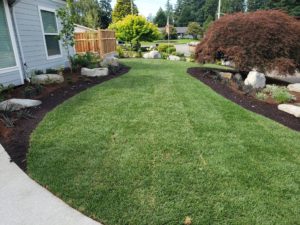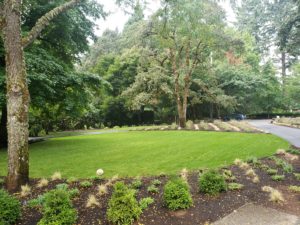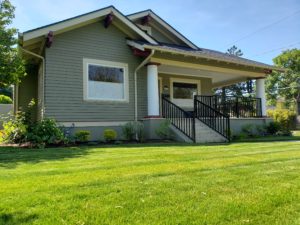The Best Grass for a Luscious Northwest Lawn
Lawns are as ubiquitous to the suburban landscape as driveways and sidewalks. Whether you are strolling through one of many historic Portland neighborhoods or a new suburban development, the single common element you are likely to see most often is a lawn. It is no wonder lawn maintenance is one of our most popular services. Because we service a lot of lawns, we thought we would share some practical knowledge about our top picks for grass varieties that thrive best in our Pacific Northwest climate.
Tall Fescue
Fescues are well suited to our climate, but there are more than 300 species of Fescue with a wide range of uses and benefits. More than 80% of the lawns we install are drought-resistant and shade-tolerant Tall Fescue. This is an eco-friendly grass with a lower nitrogen requirement—so it needs less water—that is highly adaptable and can thrive in varying site conditions. It also has a deep root system and aggressively generates tillers, shoots, and rhizomes resulting in a more dense turf quality throughout the growing season.
Perennial Ryegrass
 Perennial Ryegrass is a cool-season variety that performs well in the Willamette Valley with our moderate temperatures throughout the year but is also winter-hardy. While this grass variety requires more sunlight than Fescue (minimum 6 hours direct sunlight), it is disease resistant, yields a nice green color, and has a fine-blade dense turf. We use a blend that is 30% spreading Perennial Ryegrass which helps with durability and self-repair, making it ideal for areas of heavy foot traffic. Lawns of this variety also establish quickly as germination is fast, and its rapid emergence helps to suppress weeds.
Perennial Ryegrass is a cool-season variety that performs well in the Willamette Valley with our moderate temperatures throughout the year but is also winter-hardy. While this grass variety requires more sunlight than Fescue (minimum 6 hours direct sunlight), it is disease resistant, yields a nice green color, and has a fine-blade dense turf. We use a blend that is 30% spreading Perennial Ryegrass which helps with durability and self-repair, making it ideal for areas of heavy foot traffic. Lawns of this variety also establish quickly as germination is fast, and its rapid emergence helps to suppress weeds.
For yards with varying conditions of both sun and shade, a blend of 30% Fine Fescue and 70% Perennial Ryegrass is optimal. You get the best of both worlds and a lawn that will thrive in the hot sunny locations as well as the partial shade areas of your yard. This is also an excellent choice for overseeding an existing lawn with rapid germination to fill in thin or bare patches. The result is a fine-textured, dark green turf.
So how do you know what type of grass is best suited to your yard? The answer might actually be a blend but ultimately depends on certain factors. These factors include intended uses, foot traffic, shade, irrigation, and soil. In fact, soil condition is one of the most important considerations when getting ready to plant grass seed or install a new lawn, and for maintaining a healthy thriving lawn.
Our lawn care experts at Landscape East & West can help you with grass selection, as well as soil testing and amendments, overall lawn care tips, and on-going maintenance so you can simply relax and enjoy your own luscious northwest lawn!

